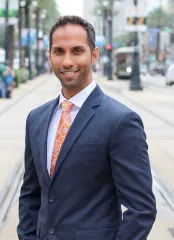Guest post by Deepak Saini, Media Strategist, Communications and Outreach Division

Last year, Alejandro Mayorkas, Secretary of the Department of Homeland Security, raised the LGBTQ+ Pride flag for the first time in DHS’ history. This Pride Month, he continues the new tradition.
To see solidarity from within one of the highest branches of federal government feels liberating. This month, we’ll see Pride celebrations across the country, global brands and companies proud to stand with the LGBTQ+ community—I can’t even begin to describe what a welcome change it is.
Even in today’s age where there is more acceptance, discrimination and hate crimes are still common. And many who identify as LGBTQ+ are still fighting an internal struggle. That’s why people like me still need allies.
Please allow me to explain this struggle: How do you truly feel pride, when you’ve spent more than half of your life being forced to hide a part of who you are?
Oxford English Dictionary defines pride as, “Confidence and self-respect as expressed by members of a group, typically one that has been socially marginalized, on the basis of their shared identity, culture and experience.”
I admit, I’ve struggled with confidence and self-respect most of my life. These days, I’m in a peculiar place with myself; trapped somewhere between the new more confident me and the younger me that is still healing.
Society was in a much different place when I was growing up in the 80s and 90s. The LGBTQ+ community faced rampant discrimination and homophobia during the HIV/AIDS crisis. Seeing this all play out on TV as a child—I knew I had to suppress this small part of me because that’s the only part the world seemed fixated on.
It’s a hopeless feeling when you’re bullied, punished or have your life threatened for the one thing about yourself that you can’t change. In all facets of my life, I worked twice as hard to show that despite my sexuality, I could be taken seriously and was still worthy of having a seat at the table.
Before joining DHS, I spent most of my career as a TV news anchor and reporter, starting with my first job in Casper, Wyoming. I was happy to receive my first break but was immediately terrified. I moved to a state where just eight years earlier, Matthew Shepard, a 21-year-old openly gay University of Wyoming student was beaten, tortured and left to die on a split-rail fence in Laramie. The shocking news caused an international outcry—and a heavy pit in my stomach.
Never in my wildest dreams would I have imagined getting a chance to interview Matthew’s mother, Judy, while I was reporting on the premiere of The Laramie Project, a play that examined how her son’s murder transformed the small town. She gave me a long hug at the end of the interview. I think she knew how badly I needed a mother’s hug.
One of my first assignments as a reporter was to cover a protest at the only movie theater in Casper willing to show Brokeback Mountain, a 2005 film that depicted a love story between two men set in rural Wyoming. Angry residents shouted homophobic slurs into my microphone and toward the patrons showing up to watch the movie. From the back of the theater, I couldn’t help but notice the silhouettes of men in cowboy hats scattered throughout the rows, sitting alone—perhaps seeing parts of their own lives playing out on screen.
More than a decade later in my TV journalism career, the Supreme Court made a landmark ruling, legalizing same-sex marriage. I’ll be honest when I say that I never expected this to happen in my lifetime. Two years later, I would meet the man that I would eventually marry. For the first time in my life, I felt I finally had a seat at the table, not because I had to earn it, but because it was my right as an American citizen—just like it was for everyone else.
Now, as a media strategist within the Science and Technology Directorate at DHS, I often reflect on my admiration and respect for my colleagues who sit at the table alongside me. Collectively, we each passionately do our part to support our DHS personnel on the front lines, safeguarding our country so families of all kinds can go to sleep at night knowing they’re safe.
Recognizing diversity is key to our collective success at DHS. Our workforce comes from all sectors—sexual orientation, race, gender origin and identity, age, religion, culture, socio-economic status and so on. None of these differences between us matter when it comes to the ability to do our jobs, but they play an important role in adding to diverse perspectives that improve our ability to complete our missions.
We come from all walks of life and truly mirror the American public we work so hard to protect.
As DHS commemorates Pride month, along with many other organizations and businesses around the country who will raise the rainbow flag, you also raise our confidence, self-respect and our healing.
Deepak Saini is a media strategist with the Department of Homeland Security (DHS) Science and Technology Directorate (S&T). Prior to DHS, Deepak was an award-winning television news journalist for several tv-affiliates across the country before transitioning to communications. Deepak earned a Bachelor of Arts in Broadcast Journalism from San Francisco State University.
